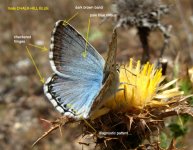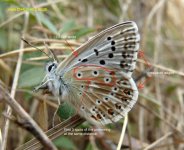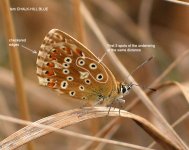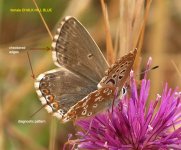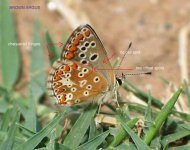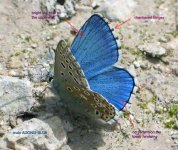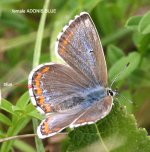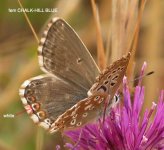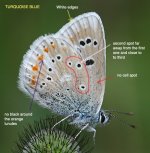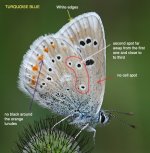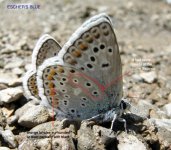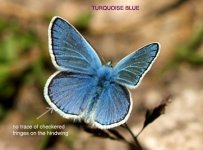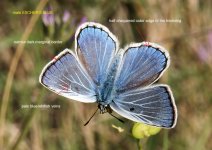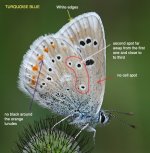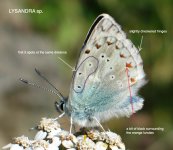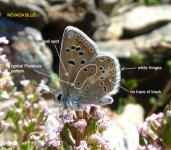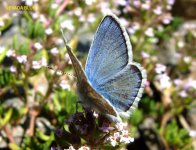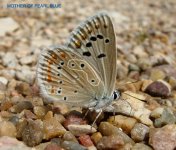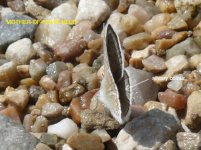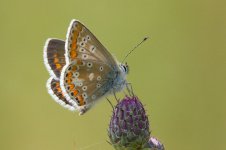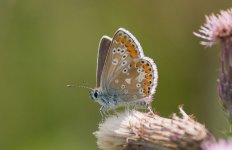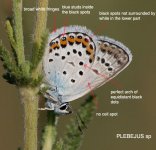Gavia_immer
Loony the Loon
Chapter 4: The Lysandra Blues: Chalk-hill Blue
I am going to work now on the Lysandra Blues as there are two common and widespread species in Europe. I start with the Chalk-hill Blue.
The Chalkhill Blue (Lysandra coridon)is a rather big Blue and it is found on calcareous soil. The male upperwing is a pale blue colour. It has chequered fringes and has a dark brown band on the border of the blue surface. The most characteristic ID tip is the pattern of the rear wings, which have small spots and brown edge band fringed with white. (pic 1)
The underside is quite characteristic but extremely variable. No problem in most of Eupope as only Adonis Blue is somehow similar. But here in Spain, where there are other similar species, the Lysandra species can be a nightmare. And that variation doesn't help at all.
As I said in a previous post about Common Blue, it is the position of the spots what tells you the Genus of a butterfly. And this is even more important with the Lysandra species. Never trust the size, the intensity or the faintness of the spots. That can be very deceiving.
I am posting a typical specimen of Chalk-hill Blue (pic 2) with the four basal spots in line and the spots forming an arch. There is a cell spot (sometimes even two) and usually a central spot inside a pear shaped white dot and a white area just below the orange lunules. But again, be careful about trusting those last two too much as ID tips (other butterflies have them too, as Brown Argus). Females look the same than the male on the underwing but the background colour tends to be darker brown. (pic 3)
Female upperwing is brown and also shows a diagnostic pattern on the lower hindwing. (pic 4)
Now, don't you think that female Chalk-hill Blue looks rather similar to Brown Argus, particularly on the underwing? Pay attention to the first 3 spots of the arch of the underwing. They are equidistant. Remember the already famous double offset spots of Brown Argus, which doesn't exist in Chalk-hill Blue. Plus Chalk-hill Blue is a large Blue while Brown Argus is very small (pic 5, for comparison)
I am going to work now on the Lysandra Blues as there are two common and widespread species in Europe. I start with the Chalk-hill Blue.
The Chalkhill Blue (Lysandra coridon)is a rather big Blue and it is found on calcareous soil. The male upperwing is a pale blue colour. It has chequered fringes and has a dark brown band on the border of the blue surface. The most characteristic ID tip is the pattern of the rear wings, which have small spots and brown edge band fringed with white. (pic 1)
The underside is quite characteristic but extremely variable. No problem in most of Eupope as only Adonis Blue is somehow similar. But here in Spain, where there are other similar species, the Lysandra species can be a nightmare. And that variation doesn't help at all.
As I said in a previous post about Common Blue, it is the position of the spots what tells you the Genus of a butterfly. And this is even more important with the Lysandra species. Never trust the size, the intensity or the faintness of the spots. That can be very deceiving.
I am posting a typical specimen of Chalk-hill Blue (pic 2) with the four basal spots in line and the spots forming an arch. There is a cell spot (sometimes even two) and usually a central spot inside a pear shaped white dot and a white area just below the orange lunules. But again, be careful about trusting those last two too much as ID tips (other butterflies have them too, as Brown Argus). Females look the same than the male on the underwing but the background colour tends to be darker brown. (pic 3)
Female upperwing is brown and also shows a diagnostic pattern on the lower hindwing. (pic 4)
Now, don't you think that female Chalk-hill Blue looks rather similar to Brown Argus, particularly on the underwing? Pay attention to the first 3 spots of the arch of the underwing. They are equidistant. Remember the already famous double offset spots of Brown Argus, which doesn't exist in Chalk-hill Blue. Plus Chalk-hill Blue is a large Blue while Brown Argus is very small (pic 5, for comparison)




